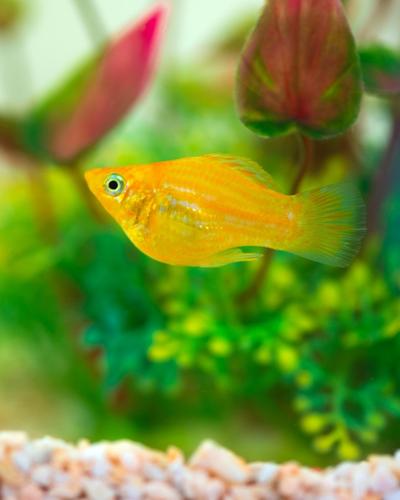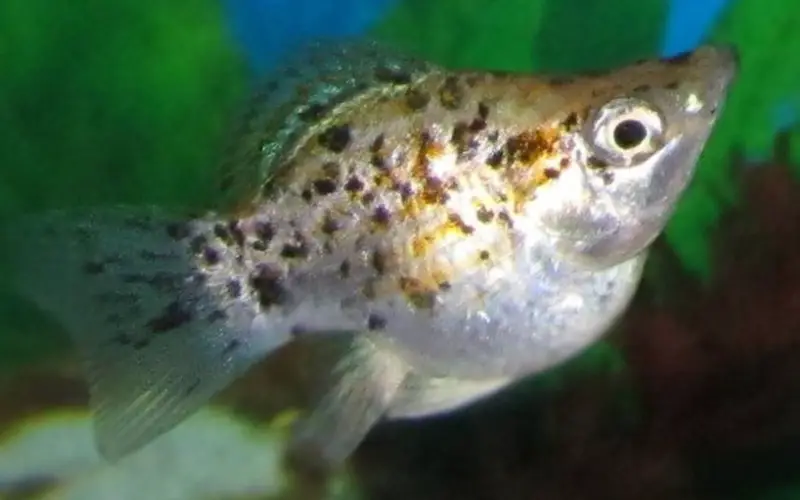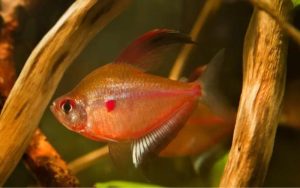It is important to understand the Molly Fish Pregnancy Cycle. To have a successful breeding experience,
Many people are not aware of the Molly Fish Pregnancy stages, which can lead to unsuccessful breeding and fish that are not healthy.
Are you looking to become a Molly fish breeder and want to learn more about their pregnancy cycle? If so, then you’ve come to the right place.
This guide will help you create a healthy environment for your tropical fish and increase your chances of successfully breeding molly fish experience.

In this blog post, we’ll cover everything from understanding mating behaviors, identifying pregnant molly fish, what food and water changes are required throughout each stage of pregnancy as well as all other important considerations for successful breeding.
So if you’re ready to dive into the world of Molly Fish Breeding – let’s begin!
Table of Contents
ToggleAt What Age Does the Molly Fish Reproduce?
Mollies can reproduce once the males have been 12 months of age. Fish then breeds and produces fry. The molly breeding cycle begins once the male fertilizes the female.
What are the Different Stages of a Molly fish pregnancy?
The Molly Fish Pregnancy Cycle has four distinct stages: Pre-Pregnancy, Embryogenesis, Hatching, and Fry Development.
Molly Fish Pregnancy Stages
During pregnancy, females of molly fish have varying stages of development. Throughout this period, a person can expect conceptions of embryos and eggs, embryo development, pre-birth, and babies’ births.
Embryo Formation Stage
Once the female is fertilized, her body will begin to form and develop eggs in the ovary. After a while, embryos will be formed and released into her oviducts, which will continue to develop until they are ready to hatch.
Embryo Develop Into Fry
The eggs have developed into Molly fry as pregnancy progresses. During pregnancy, Molly’s belly swells in size, and her color may change slightly. This indicates that she’s carrying fry as the fish will appear quite round during this period.
Pre-Birthing Stage
This is an early phase of production. Often if one watches pregnant fish closely, one will notice fry eyes on their mother’s belly before the fry is born.
Birthing Molly Fries
Mollies give life-size fish. They swam once they arrived. You have to protect molly fish from their mother and other fish as they are very vulnerable in the first few weeks of their life.
How To Identify Pregnant Molly Fish?
How can you tell If a molly fish is pregnant? Pregnant molly about to give birth is not surprisingly easy to identify. Here are some molly fish close to giving birth signs
Behavioral Changes
Fortunately, fishkeepers find detecting a pregnancy easier because of Molly’s pregnancy actions. Upon introducing fish, the calm Molly will become somewhat aggressive. However, it does not mean Molly will attack someone without any explanation.
Rather, a pregnant Molly does not enjoy other fish who disrupt their resting places. Pregnant mollies spend more of their lives in comfortable hiding spots while pregnant.
A Swollen Belly
Male and female mollies with torpedo-shaped bodies and sexes have naturally prominent stomachs. During pregnancy, the belly of Molly grows bigger and squarer. The abdomen may stretch out several weeks after fertilization. Mollies can produce as many mollies as they want, explaining their round belly during pregnancy.
Dark Gravid Spot
Livebearers have a gravid area near a nasal aerator. The spots grow larger as the woman gives birth to live fish. In the beginning, molly fish pregnant has blackish marks on their gravid. This pattern will become more apparent with time, most notably in lighter-colored mollies. It is likely, however, difficult for a black molecular to find such dark spots near the anal vent.
A Pregnant Molly Fish Will Eat More
Pregnant female molly will eat less because the babies need a lot of food. If your female Molly Fish eats more than normal, it could be due to their pregnancy.
Increased Proximity to Water Heater
Another intriguing clue to Molly’s pregnancy is that the female fish may prefer staying near the aquarium’s water heater. There is no clear reason why Mollie is a woman. Still, professional Aquarians believe that Molly is trying to retain a constant temperature at birth. If the lighting is UV enabled, you can see a Molly fish swim near the water’s surface. UV light emits light and is incredibly effective in keeping pregnant Mollies warm.
How Often Do Molly Fish Give Birth?
Molly fish typically give birth every 30 days. The gestation period for female Molly fish can last between 21 to 40 days, depending on the species and size of the female.
During mating season, it is not uncommon for female mollies to give birth multiple times a month. After the baby fry is born, it must be immediately separated from the mother and other adult mollies to prevent them from being eaten.
When caring for Molly fry, keeping their environment consistent and clean is important. Feeding a high-quality diet of microorganisms and small crustaceans helps promote healthy growth in live fish.
Additionally, maintaining regular water changes and adjusting water chemistry levels can help ensure your Molly fry reaches maturity in a healthy and safe environment.
Following these steps can help maximize the chances of successfully raising Molly fry. With patience, care, and diligence, you can grow some beautiful new Mollies!
How Long Does It Take for Molly Fish to Give Birth?
Molly Fish stay pregnant for around 60 days to be ready to give birth. During this time, they will grow their eggs and eventually release them.
The actual birthing process typically lasts up to a few hours, during which the fish may lay anywhere from 20 to 100 fry, depending on the species.
Depending on the temperature and water conditions in your aquarium, the eggs will take anywhere from three to seven days to hatch.
After hatching, the fry can take another 30-60 days to reach maturity and become full-sized Molly Fish. During this time, you must provide ample food and clean water for the fry.
With patience, you will eventually have some amazing new Mollies swimming in your aquarium!
Whether looking for a fun way to add more color and life to your aquarium or if you want to breed your own Molly Fish, understanding the signs of pregnancy can be incredibly useful.
How Long Are Molly Fish Pregnant For?
How long are mollies pregnant for? Molly gestation period can range from 21-30 days. While the exact time frame may vary depending on the species and size of the female, most female Mollies will give birth within this period.
It is important to note that a molly fish pregnant should not be kept in an overcrowded aquarium as it can put her under stress during pregnancy.
Additionally, make sure to provide plenty of nutrition and clean water throughout the entire gestation period.
Providing the right environment and care ensures that your fish has a safe and successful pregnancy. Enjoy watching your Mollies grow and thrive!
Is the Molly Fish Easy To Breed?
Molly fish can be easily grown. Like Guppies, Mollies fish reproduces frequently and is not influenced directly by humans.
Mollie’s (also known as Poecilia spiloppi) lives. Molly carries the eggs in her belly until her fetus gives birth. This could be attributed in part to aquarists creating their breeding tank.
It helps guarantee maximum survival for fry, while young fish may be susceptible to other fish in the aquariums.
What is the ideal temperature of water for molies?
The optimal temperatures of water mollies are between 24 and 27 °C or between 75-80°F. Molly fry needs an exact temperature; they are, however, digestible and grow at varying temperatures.
If the temperature is too high or low, it can cause reproduction, growth, and health issues. Therefore, if you are breeding mollies in your aquarium, ensure the temperature is adjusted to an optimal level.
Temperature fluctuations should also be avoided as they can cause stress and health problems for the fish.
How to Take Care of Pregnant Molly Fish fry
During fish pregnancy, babies should have the best possible environment and be happy and healthy.
To ensure they have the best possible environment, provide plenty of food and clean water throughout the gestation period.

Also, keep a close eye on their behavior to ensure they are not stressed or under pressure from other fish in the aquarium.
Finally, if you want to ensure the highest survival rate for fry, you can create a separate birthing tank with clean water that is just the right temperature. This will ensure that the newborn fry has plenty of room to swim and grow without competition from other fish.
How to Move Fry to Nursery Tank?
Changing the fry from the nursery to a standard aquarium can take a few easy steps. First, allow the water in both tanks to adjust to the same temperature.
Then move some of the gravel and plants from one tank to the other so there is less shock when they are transferred.
Next, use a fish net or container to scoop out the fry and place them into the new tank. Finally, check on the fry to ensure the transfer went smoothly and all of them are adjusting well.
With these few simple steps, you can easily transfer your fry from a nursery tank to a regular aquarium. They will grow and thrive in their new home with patience and proper care!
What should you feed your baby Molly Fish?
Raising molly fish for children is really easy, and they do not have problems. They are hungry, but their mouths are tiny, so they must get food.
Mollies have very short digestive processes that require frequent feeding (3-5 days a day) in tiny amounts daily.
Molluscas feed their young fry with baby brine shrimp. Try eating varied, balanced meals. Nevertheless, they may eat a lot, but be careful not to eat them.
In addition, there are also flake foods that can be purchased specifically for molly fry. Finally, always provide clean water and frequent water changes in the aquarium. This will help keep their environment clean and healthy.
When to Separate Pregnant Molly?
When to separate pregnant mollies? It would help if you separated pregnant mollies from the main fish tank approximately 3-4 weeks before giving birth. This will provide them with a secure, safe environment where they can gestate and eventually give birth without being disturbed or harassed by other fish.
Separating pregnant mollies also prevents the risk of fry predation by larger fish that may inhabit the same tank.
When possible, keep pregnant mollies in a separate tank with plenty of hiding places and plants to protect their fry.
Once the babies are born and healthy, returning them to the main aquarium is safe. However, it would help if you kept an eye on them as they may be vulnerable to predation by other tank mates.
Black Molly Pregnancy Stages
When black molly fish is pregnant, it will go through different stages of pregnancy. The first stage is fertilization, when the female and male mollies mate, and eggs are released into the water.
The second stage is called incubation when the eggs develop in their protective sacs.
After that comes hatching, when the fry emerges from their eggs; finally, the last stage is called free-swimming, when the fry swims freely in the aquarium and starts to look for food.
Dalmation Molly Pregnancy Stages
When dalmatian mollies fish is pregnant, it will also go through different stages of pregnancy. The first stage is fertilization, when the female and male molly fish mate and lay eggs that are released into the water.
The second stage is called incubation when the eggs develop in their protective sacs; after that comes hatching, when the fry emerges from their eggs.
The next stage is called fry swimming, where the fry starts to move and swim freely in the aquarium. This happens approximately five days after hatching.
Finally, the last stage is weaning, where the fry is ready to feed themselves and become fully independent.
Conclusion
If you follow the steps in this guide, you will be successful in breeding and raising fish. Patience and consistency are key throughout every stage of the process. By understanding the pregnant molly fish stages, and each fish’s individual needs and ensuring that those needs are met, you will create a safe and enriching environment for your adult fish that encourages mating and pregnancy. Thanks for reading!
You might also like
- Molly Fish Pregnancy: Overall Care Guide & (5 Breeding Tips)
- Why Do Molly Fish Laying on Bottom of Tank (5 Causes Solved)
- Bloated Molly Fish: Causes & Early Warning Signs of Dropsy
- How to Tell If a Molly Fish Is Dying? (5 Fish Sick Symptoms)
- Ideal Molly Fish Temperature: Keep your fish happy & healthy
- Molly Fish Giving Birth Symptoms (5 Signs & What to Do)
- Molly Fish Breeder Mastery: 5 Power Tips for Explosive Growth!





